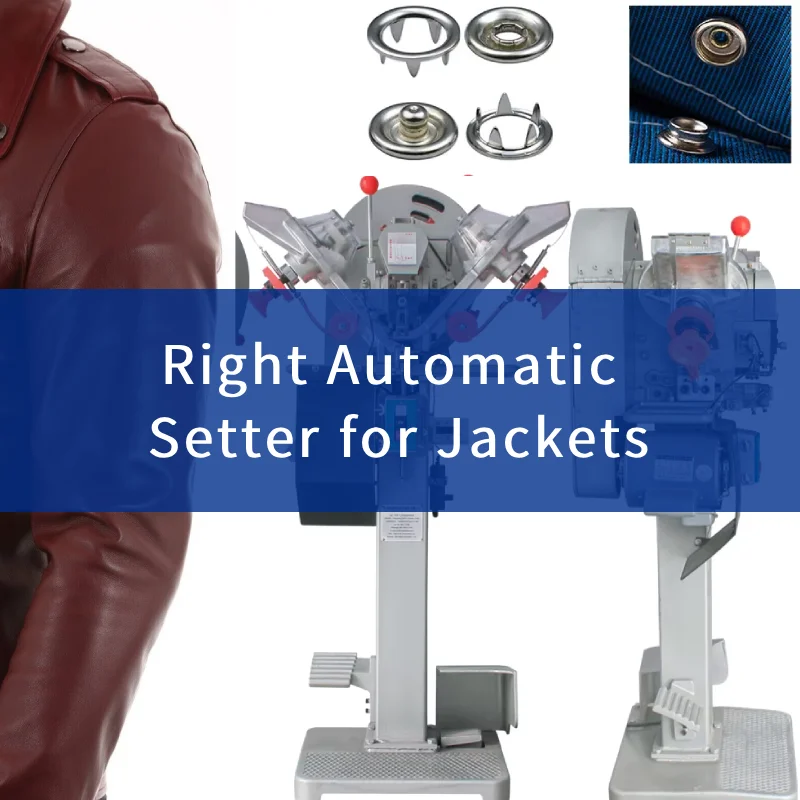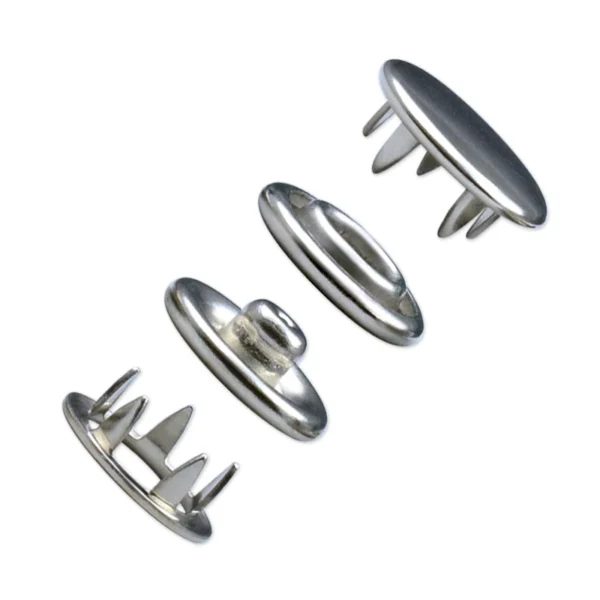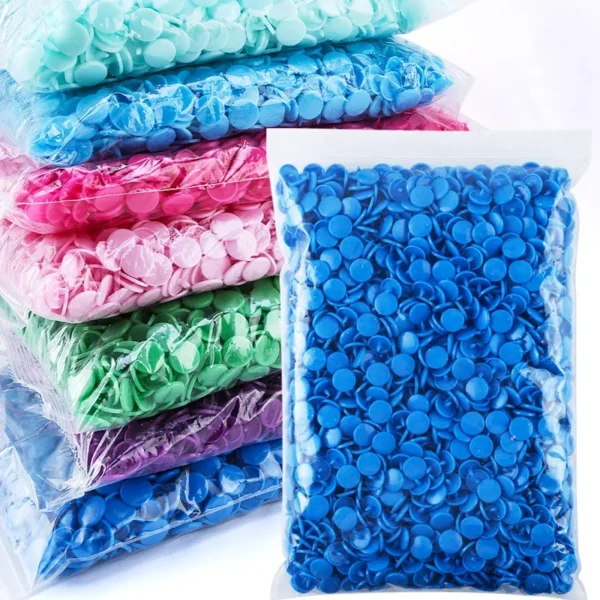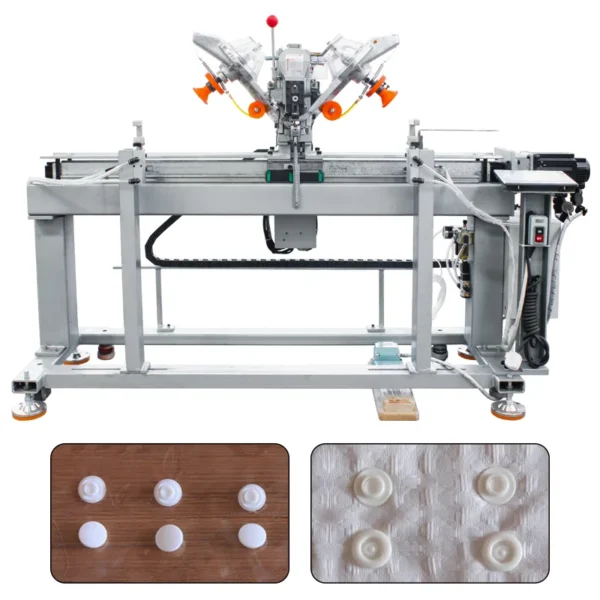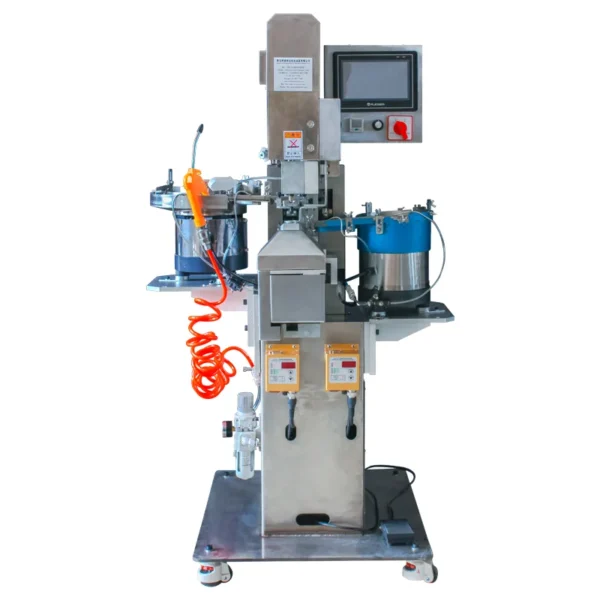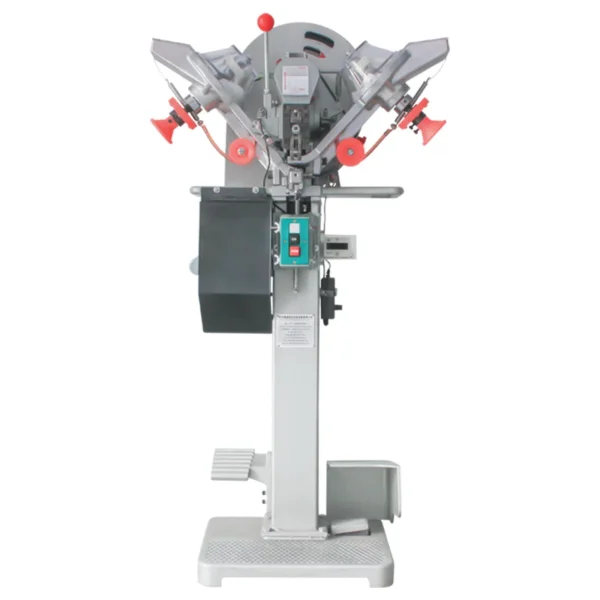Every great jacket tells a story. Sometimes, it’s the leather that catches your eye, sometimes the stitching, but often it’s the snap — that firm, satisfying click that seals the deal. As manufacturers of Automatic Snap Button Machines, we’ve learned that the humble snap button is more than just a fastener. It’s a silent signature of craftsmanship, precision, and reliability.
When a customer closes a jacket, they might not realize how much engineering hides behind that sound. Whether it’s a rugged outdoor parka, a sleek denim jacket, or a minimalist windbreaker, the choice between prong snaps and cap snaps — and the right machine to set them — makes all the difference in durability, aesthetics, and comfort.
We’ve spent years perfecting automated solutions that balance mechanical force with fabric sensitivity. In this article, I’ll share what decades of real-world experience have taught us about fastening technology, jacket design, and why choosing the correct automatic setter can elevate your entire production line.
Prong Snaps vs. Cap Snaps: What’s the Real Difference?
Let’s start with the basics — because not all snaps are created equal.
Prong snaps, sometimes called “ring snaps,” use small metal teeth (prongs) to grip the fabric. They’re ideal for thicker, layered materials like denim, canvas, or nylon. The prongs penetrate the fabric and clinch onto the socket piece, providing a deep, secure hold. You’ll often find them on utility jackets, outdoor gear, and vintage-style coats — products that demand rugged strength and long-term wear resistance.
Cap snaps, on the other hand, have a smooth dome-shaped head that presses onto the fabric surface without penetrating deeply. They’re popular for sleek, modern jackets — think bomber jackets, PU leather coats, or fashion wear — where a clean finish and refined texture matter most.
The key distinction? Aesthetic vs. structural performance. Prong snaps grip harder; cap snaps look smoother. But the right choice also depends on your fabric, production volume, and machine setup.
As a manufacturer, we’ve tested both types across hundreds of fabrics. Our conclusion? Neither is “better.” Each has its ideal environment — and the success of either depends heavily on how it’s set. That’s where the Automatic Snap Button Machine becomes the hero behind the scenes.
Why Automation Matters in Jacket Production
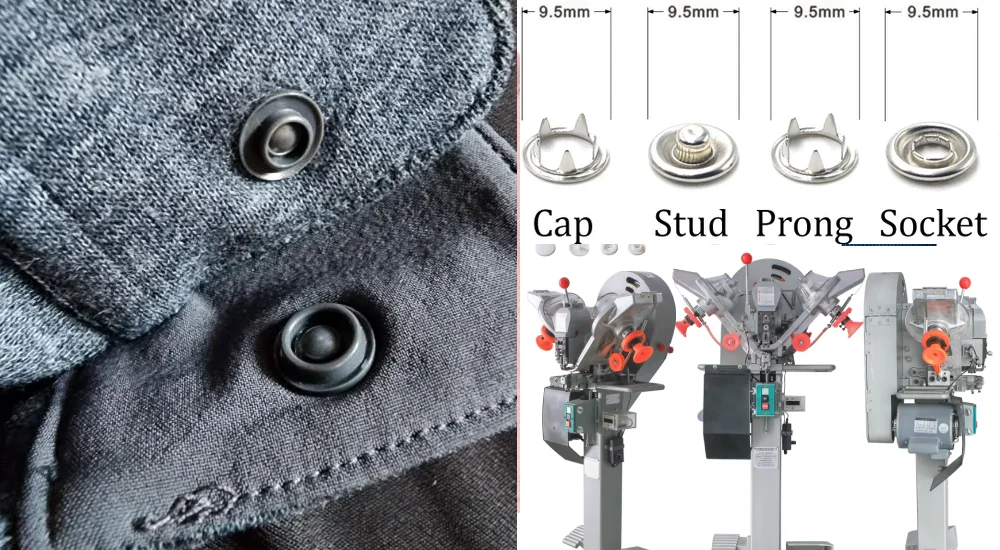
Years ago, we visited a mid-size denim factory still using manual snap presses. Each worker would position a jacket sleeve under the die, press a pedal, and hope for a clean closure. Even for skilled operators, consistency was a challenge. A slightly misaligned prong could pierce the outer layer or miss the inner lining completely. After just a few wash cycles, the snaps loosened or rusted.
That experience pushed us to rethink fastening. The truth is, modern jacket production demands precision, speed, and repeatability — qualities only automation can guarantee.
Our Automatic Snap Button Machines are designed to handle both prong and cap snaps with interchangeable molds, pressure control, and optical alignment. The difference in quality is visible from the first batch: perfectly centered snaps, zero fabric tearing, and flawless closing force across every jacket.
Automation isn’t just about convenience. It’s about protecting brand reputation. One poorly attached snap can ruin an entire product line. When you deliver consistency across thousands of jackets, your clients — and their customers — notice.
Inside the Automatic Snap Button Machine: Precision Meets Power
Every machine we design is a blend of mechanical engineering and digital control. The heart of it is the servo-driven press system, capable of applying precise force within a tolerance of ±0.1 mm. This ensures that both prong and cap snaps are installed at the perfect depth.
Here’s how it works step-by-step:
- Feeding System: Vibratory bowls separate male and female snap components automatically, feeding them into the installation head in proper orientation.
- Positioning Stage: The garment is placed under the press; alignment sensors detect fabric position and ensure the snap is centered.
- Pressing Operation: The servo system applies controlled force — adjustable for fabric type, thickness, and snap size.
- Quality Detection: Smart sensors confirm correct attachment, stopping automatically if any part is missing or misaligned.
- Data Logging: Each cycle is recorded for traceability, allowing quality teams to review production history.
With dual-head or four-head options, factories can install multiple snaps in one cycle — a game-changer for high-volume jacket manufacturing. One of our clients in Italy reported a 400% productivity increase after upgrading from manual to automated setting.
Industry Standards That Define Jacket Fastening Quality
In professional garment production, precision isn’t just preference — it’s a legal requirement. Snaps must meet international durability and safety standards, especially for export.
Our machines are built to support compliance with ISO 6330 (textile durability testing), ASTM D4846 (snap fastener strength test), and OEKO-TEX Standard 100, which ensures all materials used are free from harmful substances.
A well-set snap should withstand a pull force of 70–90 Newtons, depending on garment type. Too tight, and you risk tearing the fabric; too loose, and the snap detaches during use. Our pressure calibration system guarantees repeatability across every snap, ensuring your products meet and exceed these benchmarks.
By aligning our machine design with these global standards, we help manufacturers minimize test failures, prevent product recalls, and maintain trust with international buyers.
Field Insights: Lessons from Real Jacket Manufacturers
Experience teaches what textbooks can’t. Over the years, we’ve worked closely with jacket manufacturers around the world — from high-end leather producers in Spain to outdoor gear suppliers in Korea.
One lesson stands out: no two fabrics behave the same way under pressure. A prong snap that works beautifully on 14 oz denim may puncture through a lightweight nylon shell. That’s why adjustable force control and die selection are critical.
One of our long-time clients in Turkey shared how they struggled with leather jackets. Manual presses left uneven imprints, sometimes bruising the leather surface. After switching to our automatic machine with air-cushioned pressing heads, the problem disappeared entirely. “Now every snap feels luxury-grade,” they told us. “Our returns dropped to zero.”
It’s stories like these that keep us innovating. The difference between a good snap and a great one lies in understanding both the material science and the human touch behind each press.
Prong Snaps: Strength and Grip for Tough Jackets
Prong snaps are the backbone of rugged wear. Their design allows them to bite into dense fabrics and maintain strong retention even under stress. They’re commonly used in workwear, denim jackets, military coats, and outdoor apparel where function outranks fashion.
However, prong snaps are unforgiving if applied incorrectly. Too much force can cut threads or tear inner linings; too little, and the prongs won’t clinch properly.
That’s where the Automatic Setter earns its keep. With a smart servo controller, each prong is pressed with calculated precision. The machine senses fabric resistance in real time, adjusting downward pressure to achieve a perfect clinch — every time.
We’ve seen factories reduce snap failure rates from 7% to under 0.5% after switching to automated prong setting. That’s not just a statistic — it’s the difference between rework and reliability.
Cap Snaps: Style, Smoothness, and Surface Perfection
In contrast, cap snaps prioritize elegance. They’re ideal for jackets that demand aesthetic appeal — leather blazers, down coats, bomber jackets. Their sleek dome shape complements fashion-forward designs and hides the mechanical joint beneath a polished surface.
But style doesn’t mean softness. Cap snaps require consistent force distribution to avoid surface dents or under-pressing. Our Automatic Cap Snap Setter uses pressure feedback sensors to measure the exact deformation point of each cap. This ensures that every button sits flush with the surface — no bumps, no tilt, no discoloration.
A Japanese fashion label we worked with once told us, “Our customers buy with their eyes and judge with their fingers.” That’s why surface finish matters. Automation gives designers confidence that what they sketch on paper is exactly what comes off the production line.
Automation vs. Manual: The Performance Comparison
| Feature | Manual Snap Setter | Automatic Snap Button Machine |
|---|---|---|
| Accuracy | ±1.5 mm | ±0.1 mm |
| Fabric Compatibility | Limited | Adjustable for all fabrics |
| Productivity | 250–300 pcs/hour | 1,200–1,500 pcs/hour |
| Reject Rate | 5–10% | <1% |
| Operator Fatigue | High | Minimal |
| Consistency | Variable | Perfectly repeatable |
These aren’t just numbers. They represent the transformation happening across the garment industry — a shift from craft-driven to data-driven precision.
Ergonomics and Operator Comfort: Human-Centered Engineering
One misconception about automation is that it replaces people. In our experience, it empowers them.
Operators who once spent hours pressing pedals now manage efficient systems that do the hard work for them. Our machines are designed with low-noise pneumatic systems, foot-free operation, and touchscreen interfaces that make training quick and easy.
We’ve also implemented auto-diagnostics — if a feeder jams or pressure exceeds the set limit, the system pauses and guides the user through step-by-step troubleshooting on screen. This human-centered approach minimizes downtime and keeps morale high.
As one production manager from Vietnam said, “Your machine made our line faster — but more importantly, it made our workers happier.”
Sustainability and Waste Reduction
Sustainability is no longer optional in garment production — it’s a responsibility. Automation contributes by reducing material waste, energy use, and human strain.
Misaligned or damaged snaps often mean wasted fabric or rejected garments. By achieving near-zero error rates, our machines directly cut textile waste. We’ve also introduced energy-saving standby modes and lubrication-free pneumatic systems, which reduce carbon footprint and maintenance costs.
Factories using our automatic systems report up to 15% reduction in energy consumption compared to manual setups. That’s not just good business — it’s good citizenship.
Technology Evolution: Smart Sensors, Data Tracking, and AI
The latest generation of our machines includes smart sensors and AI-driven algorithms that analyze press force patterns in real time. This means the system can predict die wear, identify anomalies, and even alert operators before a failure occurs.
With network connectivity, factory managers can monitor production remotely. One dashboard shows real-time output, pressure data, and rejection rates — all traceable by lot number.
This fusion of Industry 4.0 principles with textile manufacturing has turned fastening into a measurable science. For jacket makers chasing both efficiency and transparency, it’s a revolution.
Customer Testimonials: What the Industry Says
Our customers — from wholesalers to global brands — often tell us that our machines redefine their production standards.
A wholesaler in Canada shared:
“We had constant complaints about loose snaps on winter jackets. Since switching to your automatic prong setter, we haven’t had a single return.”
A European fashion designer told us:
“Your cap snap machine gave our line a luxury finish we couldn’t achieve before. The buttons look handcrafted, but every one is identical.”
These words mean more to us than any sales figure. They confirm what we’ve believed from day one: automation, when done right, makes quality visible.
Why Our Automatic Snap Button Machines Stand Out
What sets us apart isn’t just technology — it’s experience. We don’t design in isolation; we co-create with factories, tailors, and engineers. Every improvement we make starts with real-world feedback.
We run our machines through 1 million-cycle durability tests, ensuring stability under continuous use. Each system is built modularly, so clients can upgrade from single-head to multi-head configurations as production grows.
Most importantly, we provide what we call “confidence engineering.” When a customer installs our machine, they’re not buying hardware; they’re investing in predictability — the assurance that every snap, every jacket, every shipment will meet the same high standard.
After-Sales Support: Partnership Beyond Purchase
Our relationship with clients doesn’t end after installation. We offer lifetime technical consultation, remote diagnostics, and training programs for operators and maintenance teams.
When issues arise — and in manufacturing, they always do — our engineers are a video call away. We also maintain regional service hubs to ensure quick response and spare parts availability.
That’s why many of our clients have stayed with us for over a decade. For them, our machines aren’t just tools — they’re trusted partners.
Conclusion
The crisp click of a jacket snap is a tiny sound that carries a big message: quality, durability, and attention to detail. Whether you choose prong snaps for strength or cap snaps for style, the real secret lies in how they’re set.
Our mission as Automatic Snap Button Machine manufacturers is to turn that invisible process into a guarantee — that every snap will close perfectly, look flawless, and stand the test of time.
Because in the end, jackets aren’t just garments; they’re experiences. And perfection, like a good snap, should always click effortlessly.
FAQs
1. Can one machine install both prong and cap snaps?
Yes. Our systems use interchangeable molds and digital pressure adjustment for seamless transitions between snap types.
2. What fabrics can it handle?
Everything from thick denim and canvas to synthetic blends and leather, thanks to our adaptive pressure sensors.
3. What’s the ROI timeframe?
Most clients recover investment within 8–12 months through reduced labor and rework costs.
4. How accurate is the pressing alignment?
Within ±0.1 mm — far superior to manual methods.
5. Is operator training difficult?
Not at all. Most users learn operation within one hour using our built-in tutorial system.
6. What certifications does the machine comply with?
CE certified, designed in line with ISO, CPSIA, and OEKO-TEX standards.

